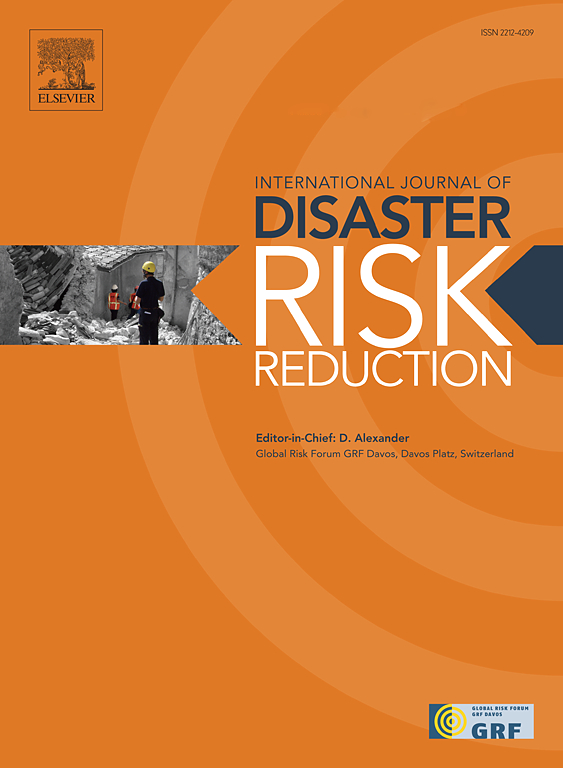Supporting “Build Back Better” in historical towns: a novel methodology to include users’ exposure and vulnerability in strategic function relocation assessment
IF 4.5
1区 地球科学
Q1 GEOSCIENCES, MULTIDISCIPLINARY
International journal of disaster risk reduction
Pub Date : 2025-07-12
DOI:10.1016/j.ijdrr.2025.105700
引用次数: 0
Abstract
Applying ‘Build Back Better’ (BBB) principles to Historical Urban Built Environments (HUBEs) means balancing sustainable structural and non-structural strategies with revitalization and preservation tasks, by addressing multiple risk factors. Among them, user exposure (“how many people?”) and vulnerability (“of which typology?”) can describe how the HUBE and its composing parts can be attractive depending on their functions, also impacting potential damage and losses. Relocating strategic functions can directly impact these factors, being strictly linked with urban policies. Existing approaches try to quantify user factors over space and time, but operational implications for decision-makers seem to be still limited. This work aims to develop a methodological framework to evaluate the multi-scale impact of function relocation in HUBEs assessing users' vulnerability and exposure at the: (1) macroscale, to evaluate if relocation can benefit the whole HUBE safety; (2) mesoscale (open space-related), to identify critical “hot-spots” in the HUBE. The framework is showcased on a significant earthquake-prone Italian HUBE. In particular, validated methodologies exploiting geospatial tools are used to generate typical use scenarios (i.e. daytime, night-time, holidays), aggregating micro-scale inputs on indoor and outdoor functions at meso/macroscales. User factors metrics are derived to compare current and relocation scenarios on selected buildings. Results demonstrate the framework capabilities in quantifying relocation impacts at the considered scales, thus providing valuable support to urban planning practices. Its implementation in decision-support systems would enable dynamic monitoring of urban development policies, prioritizing risk-reduction over space, and focusing interventions on physical vulnerability where user factors impact increases.
支持历史城镇“更好地重建”:在战略功能搬迁评估中纳入用户暴露和脆弱性的新方法
将“重建得更好”(BBB)原则应用于历史城市建筑环境(HUBEs)意味着通过解决多种风险因素,平衡可持续结构和非结构战略与振兴和保护任务。其中,用户暴露(“有多少人?”)和脆弱性(“属于哪种类型?”)可以描述HUBE及其组成部件如何根据其功能具有吸引力,也会影响潜在的损坏和损失。战略功能的重新定位可以直接影响这些因素,与城市政策密切相关。现有的方法试图在空间和时间上量化用户因素,但对决策者的业务影响似乎仍然有限。本工作旨在建立一个方法框架来评估HUBE功能迁移的多尺度影响,评估用户的脆弱性和暴露程度:(1)宏观尺度,评估迁移是否有利于整个HUBE的安全;(2)中尺度(开放空间相关),识别HUBE中的关键“热点”。该框架展示在一个地震多发的意大利HUBE上。特别是,利用地理空间工具的验证方法用于生成典型使用场景(即白天,夜间,假期),在中观/宏观尺度上聚合室内和室外功能的微观尺度输入。用户因素指标的推导是为了比较选定建筑物的当前和搬迁方案。结果表明,该框架能够在考虑的尺度上量化搬迁影响,从而为城市规划实践提供有价值的支持。它在决策支持系统中的实施将能够动态监测城市发展政策,优先考虑减少风险而不是空间,并将干预重点放在用户因素影响增加的物理脆弱性上。
本文章由计算机程序翻译,如有差异,请以英文原文为准。
求助全文
约1分钟内获得全文
求助全文
来源期刊

International journal of disaster risk reduction
GEOSCIENCES, MULTIDISCIPLINARYMETEOROLOGY-METEOROLOGY & ATMOSPHERIC SCIENCES
CiteScore
8.70
自引率
18.00%
发文量
688
审稿时长
79 days
期刊介绍:
The International Journal of Disaster Risk Reduction (IJDRR) is the journal for researchers, policymakers and practitioners across diverse disciplines: earth sciences and their implications; environmental sciences; engineering; urban studies; geography; and the social sciences. IJDRR publishes fundamental and applied research, critical reviews, policy papers and case studies with a particular focus on multi-disciplinary research that aims to reduce the impact of natural, technological, social and intentional disasters. IJDRR stimulates exchange of ideas and knowledge transfer on disaster research, mitigation, adaptation, prevention and risk reduction at all geographical scales: local, national and international.
Key topics:-
-multifaceted disaster and cascading disasters
-the development of disaster risk reduction strategies and techniques
-discussion and development of effective warning and educational systems for risk management at all levels
-disasters associated with climate change
-vulnerability analysis and vulnerability trends
-emerging risks
-resilience against disasters.
The journal particularly encourages papers that approach risk from a multi-disciplinary perspective.
 求助内容:
求助内容: 应助结果提醒方式:
应助结果提醒方式:


